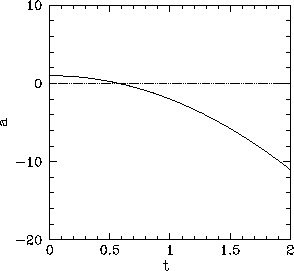| (15) |
Acceleration is the rate of change of velocity with time.This definition implies that
How should we choose the
time interval
![]() appearing in Eq. (15)? Again, in the
simple case in which the
body is moving with constant acceleration, we can make
appearing in Eq. (15)? Again, in the
simple case in which the
body is moving with constant acceleration, we can make
![]() as
large or small as we like, and it will not affect the value of
as
large or small as we like, and it will not affect the value of ![]() . Suppose, however,
that
. Suppose, however,
that ![]() is constantly changing in time, as is generally the case.
In this situation,
is constantly changing in time, as is generally the case.
In this situation,
![]() must be kept sufficiently small that the body's acceleration
does not change appreciably between times
must be kept sufficiently small that the body's acceleration
does not change appreciably between times ![]() and
and
![]() .
.
A general expression for instantaneous acceleration, which
is valid irrespective of how rapidly or slowly the body's acceleration changes in time,
can be obtained by taking the limit of Eq. (15) as
![]() approaches
zero:
approaches
zero:
| (17) |
 |
Fortunately, it is generally not necessary to evaluate the rate of change of acceleration with time, since this quantity does not appear in Newton's laws of motion.